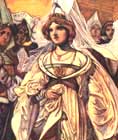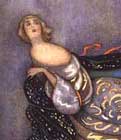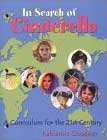
Cinderella:
345 Variants
by Marian
Roalfe Cox
SurLaLune's
Cinderella Area
SurLaLune Fairy Tales Main Page
231
Carnoy, E. Henry, and Nicolaides, Jean, Traditions populaires de l'Asie Mineure. Paris, 1889. Pp. 91-106. No. V. (Collected in the Island of Chio.)
"MARIETTA ET LA SORCIERE, SA MARATRE."
ABSTRACT
Governess prompts heroine to murder mother--Ill-treated heroine (by step-mother)--Outcast heroine, exposed on mountain-top---Heroine takes food from giants' castle; is discovered befriended by forty giants--Step-mother learns from Sun that heroine is more beautiful than she; goes as pedlar, and sells enchanted ring to heroine, who falls dead. Removal of ring restores animation--Step-mother throws bunch of grapes; heroine takes one, falls dead. Is exposed on mountain; found by hunting prince, and taken to palace--Lovesick prince--King shakes corpse. Reanimated heroine--Happy marriage- -Step-mother as midwife attends heroine; plunges fork in her head, transforming her to pigeon; takes her place--Pigeon killed for broth; bones become three fir-trees--Fir-trees uprooted for decoction; hark becomes blue pigeon. Prince takes fork from pigeon's head, causing series of transformations--Villain Nemesis.
TABULATION
(1) Marietta, when twelve years old, is sent daily to school, and brings letters to lather from schoolmistress, who is in love with him. At length school-mistress, resolving to kill her rival, bids Marietta ask her mother to dress her in best clothes to go for walk with governess. Whilst mother is getting them out of chest, Marietta is to let marble lid fall down on her head, and mother will laugh at the joke. Marietta does as bidden, and her mother is killed.-- (2) Some time after, governess marries father, and becoming jealous of his love for Marietta, plans her ruin, falsely accusing her of breakages, etc. At length she tells him he must choose between wife and daughter, and father takes Marietta and exposes her on the top of distant mountain, and afterwards takes her a box of provisions to last one year.-- (3) At the end of that time Marietta descends to valley, and sees magnificent castle, the home of forty giant brothers. During their absence she enters and prepares excellent repast, of which she partakes, then returns to her mountain. Brothers are astonished to find nice supper prepared. Marietta does same thing two following days; then one of the giants decides to hide and see who comes. Eldest giant stands behind principal entrance to palace, but misses seeing Marietta, who enters another way. Thirty-nine of them keep watch in this way, and fail to see visitor; then youngest giant must take his turn. If it is a man he finds, he shall be their brother; it a girl, their sister. Youngest giant places him self at little door of palace, and when Marietta is about to leave, he stops her. Giants return, and are delighted to have a sister. They give her the prettiest room, and each one puts a gold ring on her finger.-- (4) Meanwhile Marietta's parents think her dead. Stepmother says to the sun,1 "Beautiful Sun, who makest the tour of the world, tell me, hast thou ever seen a woman more beautiful than I am?" Sun answers, "I am beautiful, and so are you, but not so beautiful as Marietta." "She is living, then?" "Yes, she is queen of the giants!" "Is she happy?" "Happier than you are." "Where is her palace?" "At the foot of the mountain."-- (5) Stepmother, who is a witch, changes herself into a pedlar, and goes to palace with wares for sale. Marietta buys an enchanted ring; when she puts it on her finger she falls dead. Giants return; are greatly distressed; inquire who has entered palace, and hear about ring. Eldest says it must be taken off her linger. Which is it of the forty-one rings she is wearing? Each giant removes his own gift, and the enchanted ring remains. Eldest giant takes it off, bringing Marietta to life.2 -- (6) Some time after stepmother holds same parley with sun, and learning that Marietta still lives, transforms herself into grape-seller, and calls "Fine grapes" under Marietta's window. Servants have orders to admit no one, so stepmother throws bunch of grapes in at window. Marietta takes one grape and falls dead. Giants are sorrowful, agree she is too lovely to be buried in earth, and resolve to expose her on mountain-top, reposing amongst flowers.-- (7) King's son, out hunting, sees something shining on mountain, and says to courtiers, "If it is treasure, you may have it; if anything else, it belongs to me." They find a huge gilded chest, and on opening it see beautiful corpse inside. Prince has it taken to palace. He sickens day by day; parents cannot imagine why. He locks his room whenever compelled to leave it. King goes to war at head of his army.-- (8) One day courier brings letter to son, saying he must at once join father; the state is in danger. This is a feint, for king has returned victorious that very night. In his haste to obey, prince forgets to lock room, which king and queen enter. Having gazed awhile on Marietta, king presses her chest, then her throat, to see if she is alive or dead. The movement makes her quiver; she coughs, and the grape falls from her mouth. She sits up, and cannot remember what has happened.-- (9) Prince is fetched back, enters his room, and finds Marietta surrounded by all the court, lie is married to her next day.-- (10) Stepmother once more questions sun in same words ; learns that Marietta is wife of powerful prince, and where his palace lies. She comes to capital of Marietta's kingdom, and writes on all the walls of town that celebrated midwife has just arrived. Prince engages her to attend Marietta, who bears beautiful boy. Stepmother plunges fork into Marietta's head, transforming her into pigeon;3 takes her place in bed.-- (11) Every morning white pigeon asks gardener," Is the king asleep?" "Yes, he sleeps." "May he sleep well and have happy dreams! Is his wife asleep? . . . May she sleep ill, and have awful dreams!" Puzzled gardener at length tells prince of daily occurrence. Prince rises early, and when pigeon comes she sits on his shoulder. He has it put in gold cage, and taken to his room. Every morning pigeon says, "Are you asleep, my prince? Sleep well, etc. Is your wife asleep? etc."-- (12) One morning witch hears bird talking to prince; knows it is Marietta; tells prince she is very ill, and must have broth made from pigeon. Prince hesitates, but still believing woman is Marietta, sacrifices pigeon. Witch swallows broth and throws bones into corner of garden.-- (13) Three pine-trees grow from the spot, and, as prince passes, leaves murmur softly, pines bow three times. Witch knows trees have sprung from pigeon's bones, and tells prince she is ill, and must have decoction made from root, of the three trees.-- (14) They are cut down and the bark of the roots is thrown in another corner of garden. Blue pigeon comes from bark and talks to gardener (as before).-- (15) Prince goes to see pigeon, and finds fork piercing its head, lie draws it out ; blue pigeon becomes, first, three firs, then white pigeon, then Marietta.-- (16) Prince imprisons witch in dark vault, and till day of her death gives her only bad flour moistened with a little water.
NOTES
Note 16
(P. 186.) In No. 58 (Kolberg) the stepmother inquires of her mirror who is fairest; in No. 155 (Corazzini) she asks the sun. Compare similar incidents in Arnason, p. 403, "The Story of Vilfridr Fairer-than-Vala"; Celtic Mag., xiii, p. 213, "Gold-tree and Silver tree"; Glinski, i, 149; Gonzenbach, ii, 206; Grimm, No. 53, "Little Snow-White", and variants, i, 406; Hahn, No. 103; Maurer, p. 280; Mila, p. 184; Pedroso, Portuguese F. Tales, No. I, "The Vain Queen"; Schneller, No. 23; Schott, No. 5; Wolf, p. 46. See Mr. Nutt's paper on "The Lai of Eliduc and the Märchen of Little Snow-White", Folk-Lore, iii, pp. 26 ff.
In No. 286 heroine's corpse comes
into the prince's possession, as in No. 231, and
is resuscitated in a similar manner. Compare Miss Busk's story cited in
the preceding note [Note 15]. References
to the very numerous instances of resuscitations in folk-tales are not
added here, as the incident occurs but rarely in stories belonging to
the Cinderella group.
Return to place in text.
2: [SurLaLune Note: Two superscript
footnotes appear on p. 186 of the book, but only one footnote is provided
at the bottom of the page. The footnote referencing Note 16 obviously
belongs to the first number, but it doesn't appear to apply to the second
footnote. No other note appears to apply to it either.]
Return to place in text.
Note 17
(P. 187.) In the following stories a pin stuck in the head causes transformation into a bird: Buchon, La Grece Continentale et la Moree, p. 263; Busk, F.-L. R., Nos. 2, 3; Cosquin, ii, 358; Crane, p. 341; Deulin, ii, 191 ff.; Finamore (Abbruz.), No. 50; F.-L. Journal, iii, 290, "The Black Woman and the Turtle Dove" (Chilian Pop. Tale); vi, 199, "The Three Lemons" (Hungarian tale); Legrand, p. 140 (= Buchon); Luzel, Legendes, ii, 303; Rivière, p. 53; Stokes, No. 2; La Tradition, iii, 12, 366. In an Abyssinian tale (Reinische, Die Nuba Sprache, Vienna, 1879, i, 221), a magician plunges enchanted needles into the heads of seven brothers, transforming them to bulls. When the pin is withdrawn from the bull's hide, in "The Red Bull of Norroway", he becomes a handsome prince.
In No. 17 the old wotnan transforms
the heroine into a bird while dressing her hair.
Return to place in text.
Cox, Marian Roalfe. Cinderella: Three Hundred and Forty-five Variants of Cinderella, Catskin, and Cap O' Rushes, abstracted and tabulated. London: David Nutt for the Folklore Society, 1893.
While the original text of this book is out of copyright, the special formatting and compilation available on SurLaLune Fairy Tales is copyrighted. Be aware that while the original content has been honored, page numbering, footnote numbering, redesigned charts, links, and other aspects are unique to this site's version of the text. Use at your own risk. For private and fair use educational purposes only.
©Heidi
Anne Heiner, SurLaLune Fairy Tales
E-mail: surlalune@aol.com
Page last updated February 1, 2006
www.surlalunefairytales.com










